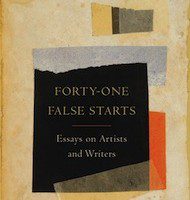1
Janet Malcolm’s latest book, a collection of her essays on artists and writers, is titled Forty-One False Starts after the opening profile on the artist David Salle. Malcolm mimics Salle’s collages and conglomerate paintings in her own writing – “a kind of parody of his melancholy art of fragments, quotations, absences – an art that refuses to be any one thing or to find any one thing more interesting, beautiful, or sobering than another” – by juxtaposing forty-one different ways she could have started the profile piece. Opening with this unusually structured essay prepares the reader from the start: this is no ordinary journalism. This is Janet Malcolm.
2
It seems impossible to read (or write) about Janet Malcolm without considering her infamous quote from the first line of her book The Journalist and the Murderer: “Every journalist who is not too stupid or too full of himself to notice what is going on knows that what he does is morally indefensible.” Malcolm has said that she used that opening line as a proposal for debate, as The Journalist and the Murderer is a book-length discussion about the morality of a writer betraying his subject. But it seems Malcolm feels the same way about her own work.
She goes on to say that the writer is “Journalists justify their treachery in various ways according to their temperaments. The more pompous talk about freedom of speech and ‘the public’s right to know’; the least talented talk about Art; the seemliest murmur about earning a living.” Malcolm doesn’t try to justify her work in any way; she keeps her mouth shut and does her job. But if Malcolm finds what she does as a journalist despicable, that might explain why she is so worshipful of artists – those who create something out of air, who smear paint on blank canvas, who conjure new characters. Malcolm describes one of Diane Arbus’s portraits as gleaming “out of Arbus’s photographic universe like a new star.” In her essay on Julia Margaret Cameron she declares: “Photography in the 1860s was not for sissies.”
“To the writer,” says Malcolm, “the painter is a fortunate alter ego, an embodiment of the sensuality and exteriority that he has abjured to pursue his invisible, odorless calling. The writer comes to the places where traces of making can actually be seen and smelled and touched expecting to be inspired and enabled, possible even cured.” Forty-One False Starts feels like just that – a place where you can actually see and smell the experience of making art, a safe haven in which to take a break from the moral guilt of nonfiction writing.
3
If Janet Malcolm is writing a profile of you, you should be scared. She has a reputation as a ruthless, brutal journalist who may smile at you in an interview but rip you apart on the page. Puff pieces do not exist in Malcolm’s world.
4
If Janet Malcolm is writing a profile of you, you should be honored. Especially if you are an artist or a writer, as it seems there is no one else Malcolm loves more in the world. High- and lowbrow, contemporary and classic, Malcolm handles her subjects with passion and care. She is moved to tears rereading Gene Stratton-Porter’s young adult novel A Girl of Limberlost – a book she first read as a girl – and she sticks up for “Zooey” as J.D. Salinger’s masterpiece. She gives as much thoughtful attention to the Gossip Girls series – “the lightest of light reading,” which she sees as a “transgressive fairy tale” – as she does to Virginia Woolf.
5
Janet Malcolm is one of the most detail-driven writers in narrative nonfiction. In her new essay collection, Forty-One False Starts, no fiber or strand gets by her. She mentions pubic hair more than once.
6
Forty-One False Starts, Janet Malcolm’s most recent essay collection and her first since The Purloined Clinic (1992), is the most fluid essay collection I have ever read. Without the dates under each essay – the collection spans 1986 to 2011 – a reader might think the entire book was written in one sitting. Malcolm’s voice is confident, strong, and unwaveringly consistent through the quarter century covered by the book. The essays seem inspired by each other, despite being written years apart. They slide from Diane Arbus’s photography (“Good Pictures”) to photography of nudes (“Edward Weston’s Women”) to nudes in general (“Nudes Without Desire”). Some of Malcolm’s essays are long journeys, like “A Girl of the Zeitgeist,” where Malcolm spends a full year interviewing Ingrid Sischy; others, like her brief but heartfelt tribute to the writer Joseph Mitchell, are like a sharp, well-deserved smack. As Ian Frazier writes in the collection’s introduction, “A lot of journalism is a bedtime story you are sleepily hearing for the hundredth time, but with a piece by Janet Malcolm you never know where things will lead.”
7
Janet Malcolm always shows up at just the right time. Throughout her most recent collection of essays, Forty-One False Starts, Malcolm makes frequent cameos. We feel her stiff fingers, too cold to take notes in Vanessa Bell’s unheated Charleston Farmhouse. She steps in to tell us of her first impression of the artist Richard Serra: “his aura was of rough small-town America rather than of bohemia. I have seen men like him standing beside pickup trucks in wintry landscapes, locked in slow, obdurate, implacable argument.” Sometimes, she makes one of her characteristically blunt statements: “I have never found anything any artist has said about his work interesting.” But more often than not, the reader finds Malcolm offering camaraderie – “Everyone who writes or paints or performs is defensive about everything,” Malcolm quotes herself as saying; “I’m defensive about not working fast enough.” – or a simple, glowing compliment: “even I, who have no vested interest in the project whatever and was initially rather repelled by the paintings, now find myself drawn.”
8

The first time I read the essay “Forty-One False Starts” by Janet Malcolm, I wrote in the margin of the piece: “god, Janet Malcolm is boss.”
9
In class, discussing Janet Malcolm’s essay “Forty-One False Starts,” my professor described Malcolm as a “samurai, not the way most mortal writers are afraid.” Malcolm does not worry about making one statement, and then, perhaps, changing her mind later in the piece. However, “Janet Malcolm,” that same professor added, “is not as well-known as Joan Didion because she’s pissed so many people off.”
10
Janet Malcolm holds her artist and writer subjects to high standards, if only because they are the same high standards to which she holds herself. “Being so careful and self-aware and circumspect with her own human subjects,” writes Ian Frazier in the introduction of Malcolm’s newest essay collection, Forty-One False Starts, “she waxes irate at the large number of writers who aren’t.”
11
In another life Janet Malcolm was a Supreme Court Judge. While there is no such thing as true objectivity, Malcolm tries her hardest to be fair. Smitten with nostalgia writing about a favorite writer from her childhood, Gene Stratton-Porter, Malcolm writes: “[on rereading the book] I felt that I was reentering an imaginative world whose grip on my own imagination had never loosened.” Malcolm is “almost crying” over a scene when the main character purchases a lunchbox, overcome by her childhood joy at reading that scene. But despite this sentimental fondness, Malcolm takes Stratton-Porter to task for the insane racism in her later novels.
In the last essay in her newest collection, Malcolm writes: “The ‘I’ of journalism is a kind of ultra-reliable narrator and impossible rational and disinterested person, whose relationship to the subject more often than not resembles the relationship of a judge pronouncing sentence on a guilty defendant.” Forty-One False Starts is a collection of Malcolm’s essays on writers and artists, and it reads like Malcolm on a both serious and affectionate visit to an art museum, gavel in hand.
But Malcolm is not a righteous egomaniac. In her essay on the Bloomsbury group, “A House of One’s Own,” Malcolm writes: “I have, like every other biographer, conveniently forgotten that I am not writing a novel, and that it really isn’t for me to say who is good and who is bad, who is noble and who is faintly ridiculous. Life is infinitely less orderly and more bafflingly ambiguous than any novel.” She is aware of what she is doing, though if I want to trust anyone to make order of the mess of real life, I choose Janet Malcolm.
12
“I see that my journalist’s habits have inhibited my self-love,” admits Janet Malcolm in the final essay of her new collection, Forty-One False Starts. Malcolm has a reputation for not letting her subjects get away with anything – for better or for worse – but what her critics often fail to acknowledge is that Malcolm doesn’t let herself get away with anything either.
13
Janet Malcolm is white chalk.
14
Janet Malcolm, the infamous journalist and New Yorker staff writer, is an artist, though you might not know it. In the first and title essay of her newest collection Forty-One False Starts, Malcolm brings with her to an interview with the artist David Salle three collages that she “made for [her] own pleasure.” Malcolm brings her collages to spark a discussion with Salle to find the distinction between works made by amateurs and works made by artists. “They’re art if you declare them to be so,” Salle tells Malcolm, being polite, but Malcolm urges Salle to give her a critique. “Looking back on the incident,” Malcolm writes after the scene, she realizes “that, for all my protests to the contrary, I had brought my art to him to be praised. Every amateur harbors the fantasy that his work is only waiting to be discovered; a second fantasy – that the established contemporary artists must (also) be frauds – is a necessary corollary.”
In Forty-One False Starts, Malcolm becomes both the writer and the artist, but not just because of her collage on the book’s cover. Ian Frazier, in the collection’s introduction, says it best: “Journalism that succeeds as art usually does not appear to be art in its presentation… Over and over [Malcolm] has demonstrated that nonfiction – a book of reporting, an article in a magazine, something we see every day – can rise to the highest level of literature.” The essays themselves are Malcolm’s art.




